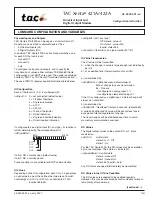
Signal override with Stop inputs
Using Stop inputs S1 - S5, any of the five signals
controlled by a TS5 can be forced to show 'stop', or
restricted to 'approach' or 'diverging approach'
indication. This can be useful when the control point
has turnouts to uncontrolled sidings.
To force Signal 1 to show 'stop', connect terminal
'S1' to any 'C' terminal. To limit Signal 1 to
'approach' for a single-head signal, or 'diverging
approach' for a dual-head signal, connect terminal
'S1' to a 1,000 ohm (1k) resistor, and connect the other end of the resistor to any 'C' terminal.
Use terminal S2 to control Signal 2 in a similar fashion. Use 'S3' for Signal 3, 'S4' for Signal 4, and 'S5' for Signal 5.
In this example, a turnout to an uncontrolled siding is between signals 1 and 4. An electrical contact is linked to the turnout
points. This contact closes ('on') when the turnout is lined for the siding. This connects terminal 'S1' to 'C', causing Signal 1
to show 'stop.' This also connects 'S4' via a 1k resistor to 'C', causing Signal 4 to show 'diverging approach.'
Signal indications and single vs. dual head signals
A single head signal shows track conditions ahead on a single track without turnouts.
A
'stop' indication
(red) means the track block immediately beyond the signal has a train in it, or an open
drawbridge or other hazard. An
'approach' indication
(yellow) means it is safe to enter the block, but the following
signal is at 'stop,' so slow down and be prepared to stop at the next signal. If 4-aspect signaling is in use (see the
signal config jumpers on page 7) an
'advance approach' indication
(flashing yellow) means it is safe to enter the
block, but the next signal is at 'approach,' so reduce speed accordingly. A
'clear' indication
(green) means the track
ahead is clear and trains may run at up to the posted speed limit ('track speed' or 'normal speed').
"Route Signaling" systems
use a dual head signal ahead of a turnout.
If the lower head indicates 'stop,' then the turnout is in the Normal position and
the upper head indicates the condition of the main track ahead.
If the upper head indicates 'stop,' then the turnout is in the Reverse position
and the lower head indicates the condition of the diverging track ahead. Trains
use lower speeds while negotiating the turnout.
When the switch is lined for the main route, the lower
head shows red (except approach medium). The upper
head indicates the condition of the main track.
indicates flashing
main
clear
main advance
approach
main
approach
stop
When the switch is lined for the diverging route, the upper
head shows red. The lower head indicates the condition
of the diverging track.
The 'stop' indication does not provide route information
because the train is to stop, not taking either route.
diverging
clear
diverging adv.
approach
diverging
approach
stop
These aspects indicate that the
next
signal shows a diverging aspect.
Approach medium
means the track ahead is clear, but be prepared to pass the next
signal at a reduced ('medium') speed.
Approach slow
means the track ahead is clear, but the next signal is 'diverging
approach.' Be prepared to pass the next signal at a 'slow' speed.
The next signal must be controlled by an Azatrax TS3 or TS5, and linked to this TS5.
approach
medium
approach
slow
© 2022 Azatrax.com
TS5 installation guide - diamond crossing
pg. 9 of 10
Electrical switch linked
to the turnout points.
1k
S1
S2
S3
S4
S5
C
TS5
si
g
n
a
l i
n
p
u
ts
track 1
Example
track 4
signal 1
signal 4
Closing this switch forces
signal 1 to show 'stop'
and signal 4 to show
'diverging approach.'




























